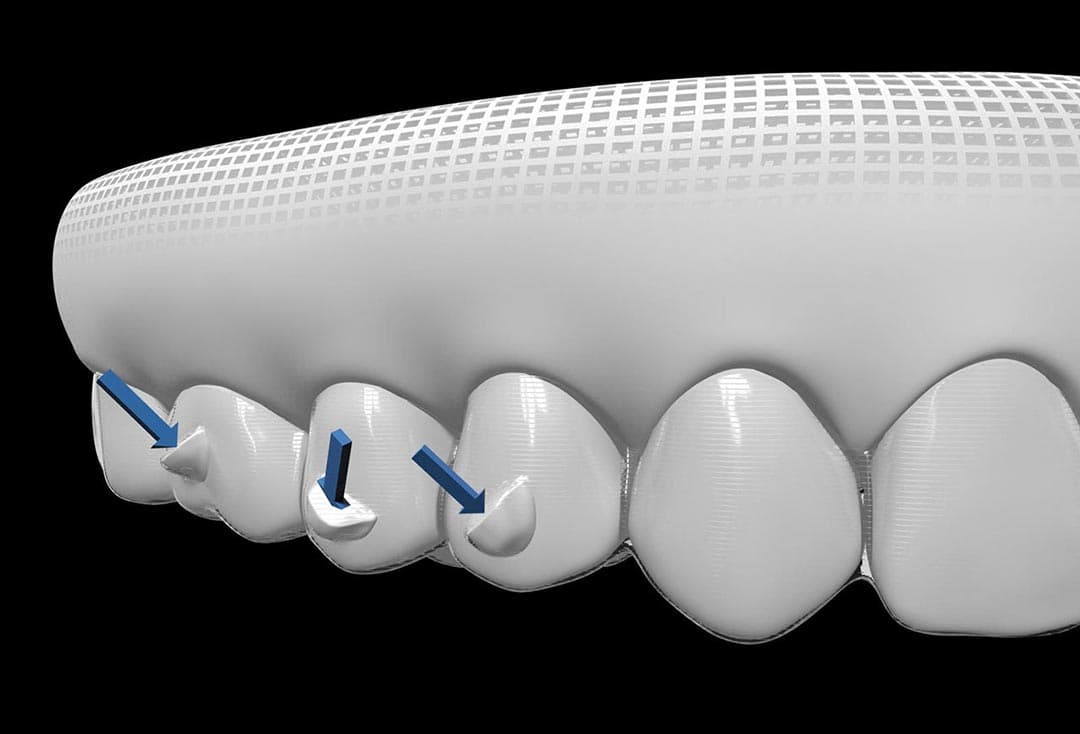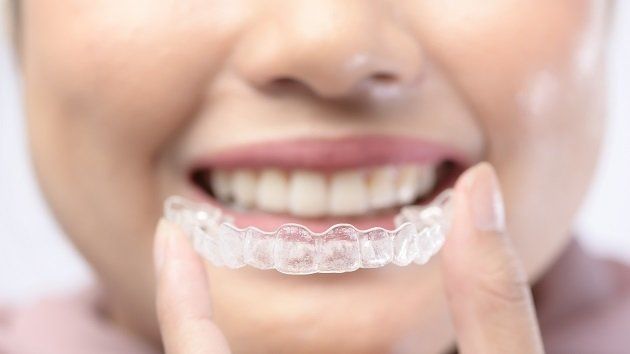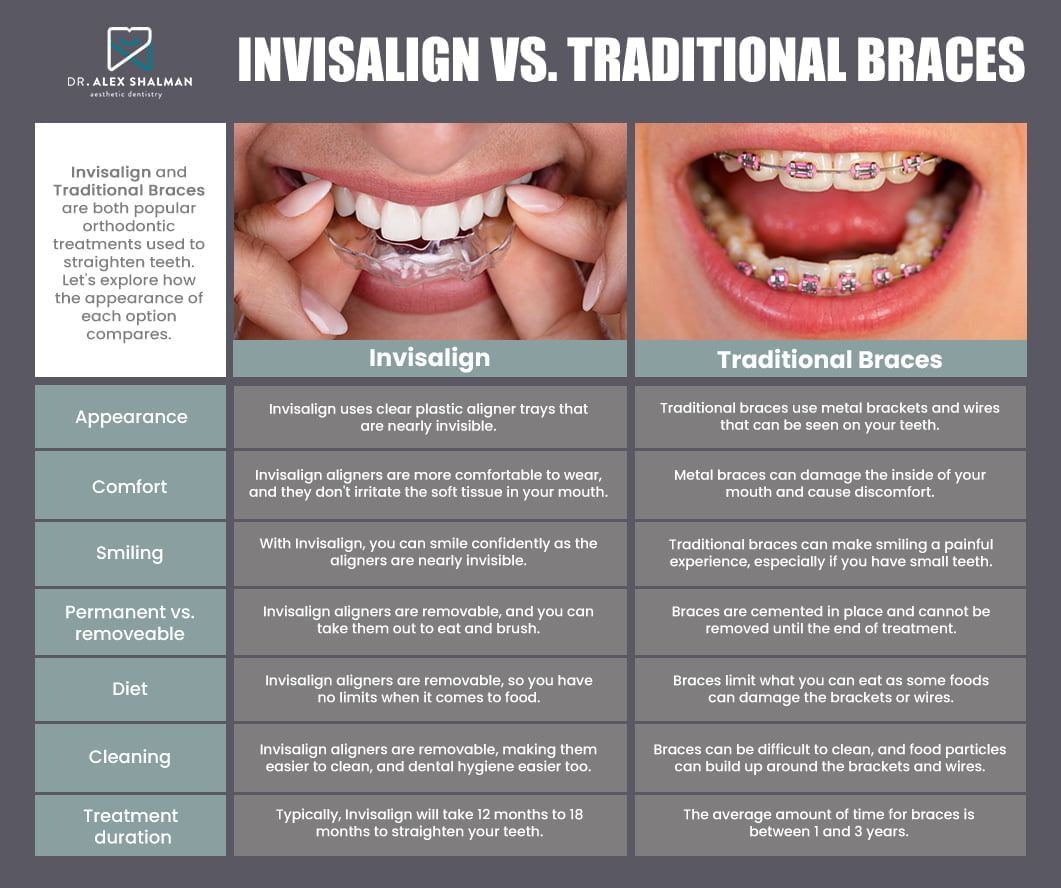Invisalign vs. Standard Braces: Which Alternative Is Right for You?
When taking into consideration orthodontic treatment, the option in between Invisalign and typical braces presents several crucial variables that warrant careful assessment. Invisalign uses a very discreet option with detachable aligners, while typical dental braces provide a more visible yet effective remedy for severe misalignment. Each option encompasses distinct advantages and drawbacks connected to aesthetics, comfort, treatment duration, and cost. Understanding these nuances is essential for making an informed decision that aligns with your personal preferences and way of life. The concern stays: which choice will finest satisfy your orthodontic requirements and expectations?
Summary of Therapy Alternatives

In contrast, standard braces contain steel brackets and cords that are bonded to the teeth. This technique uses continuous pressure over time to accomplish alignment. While efficient for complicated orthodontic concerns, conventional dental braces call for routine check outs for adjustments and can position difficulties in maintaining oral hygiene because of the trouble of cleaning around brackets and cables.
Both choices have their merits, and the option commonly depends upon specific dental conditions, way of life preferences, and individual conformity. Inevitably, seeking advice from an orthodontic specialist is essential for establishing the most suitable treatment plan tailored to individual needs. Comprehending the subtleties of each alternative can significantly influence the overall success of orthodontic therapy.
Aesthetic Considerations
A substantial aspect influencing the selection in between Invisalign and standard braces is the aesthetic allure each treatment offers. Invisalign aligners are crafted from clear plastic, making them basically undetectable when used.
On the other hand, traditional dental braces consist of steel brackets and cords, which can be a lot more recognizable. While innovations in orthodontic innovation have brought about the advancement of smaller sized brackets and tinted elastics, conventional braces still maintain a more noticeable profile. For some individuals, the exposure of braces might deter them from looking for necessary treatment.
Inevitably, the option in between Invisalign and standard dental braces may depend upon personal choices relating to visual appeals. People who focus on discretion frequently favor Invisalign, while those who are less worried about presence may decide for conventional dental braces. Comprehending the aesthetic ramifications of each option is vital for making an informed decision that aligns with one's way of life and preferences.
Convenience and Convenience

In regards to ease, Invisalign aligners are removable, enabling individuals to appreciate their favored foods without limitation and keep optimal dental hygiene. Cleaning and flossing are simplified, as the aligners can be taken out throughout these regimens, whereas traditional dental braces call for mindful maneuvering around wires and brackets.
Furthermore, Invisalign's modern system enables for less orthodontic gos to. People generally get several sets of aligners at once, which can streamline the treatment process and lower time invested in the orthodontist's chair. In contrast, typical braces necessitate routine adjustments, making them much less convenient for those with active schedules. Invisalign. On the whole, the comfort and ease of Invisalign make it an attractive selection for lots of people seeking orthodontic therapy.
Treatment Duration and Performance
While both Invisalign and conventional dental braces work in remedying oral misalignments, the period of therapy can vary significantly between both choices. Generally, Invisalign therapy read this can take anywhere from 12 to 18 months, depending on the complexity of the situation. The clear aligners work by slowly shifting teeth into their preferred placements, and normal follow-ups with an orthodontist aid guarantee development stays on course.
On the other hand, typical braces typically need a longer dedication, generally varying from 18 months to 3 years. This results from their fixed nature and using brackets and wires, which can be much more efficient for serious misalignments and complicated situations (Invisalign). The treatment efficiency of conventional dental braces is well-documented, as they enable specific adjustments and greater control over tooth movement
Ultimately, the choice in between Invisalign and typical dental braces may depend upon both the expected therapy duration and the particular oral concerns at hand. Consulting with an orthodontist is essential, as they can offer tailored referrals based on private needs, making certain the picked technique straightens with desired results and timeframes.
Cost Comparison and Insurance Coverage Alternatives
Expense plays a significant function in the decision-making process for people taking into consideration orthodontic treatment, whether choosing Invisalign or typical dental braces. On standard, the cost of other Invisalign arrays from $3,000 to $8,000, while standard dental braces normally cost in between $2,000 and $6,000. Elements influencing these prices include the intricacy of the instance, the duration of therapy, and geographical area.
Numerous oral insurance plans give partial coverage for orthodontic therapies, but the specifics can differ commonly. Generally, conventional dental braces may be a lot more regularly covered by insurance plans compared to Invisalign, which some insurance providers classify as an aesthetic procedure.
Additionally, a number of orthodontic methods supply flexible repayment strategies, making both therapy options much more obtainable. Patients ought to ask about prospective funding alternatives and discounts for in advance repayments. Examining the complete price, consisting of insurance benefits and layaway plan, is vital for making a notified choice that lines up with both aesthetic preferences and budget plan factors to consider.

Verdict
In recap, the selection in between Invisalign and typical dental braces depends upon numerous internet variables, consisting of visual preferences, comfort, treatment period, and cost. Invisalign provides a discreet, removable alternative that facilitates dental health and nutritional versatility, while conventional braces may be better for intricate oral problems and typically come at a lower rate point. Eventually, assessment with an orthodontist is vital to evaluate individual conditions and establish one of the most proper treatment option for attaining optimum dental alignment.
When taking into consideration orthodontic therapy, the choice in between Invisalign and standard braces presents a number of vital aspects that warrant careful evaluation.Contrasting Invisalign and conventional braces reveals unique therapy alternatives for orthodontic correction.While both Invisalign and traditional dental braces are efficient in remedying oral imbalances, the period of therapy can differ considerably between the 2 choices.Expense plays a substantial function in the decision-making procedure for individuals thinking about orthodontic therapy, whether choosing for Invisalign or conventional dental braces.In recap, the selection between Invisalign and conventional braces pivots on several elements, consisting of aesthetic preferences, convenience, treatment duration, and expense.